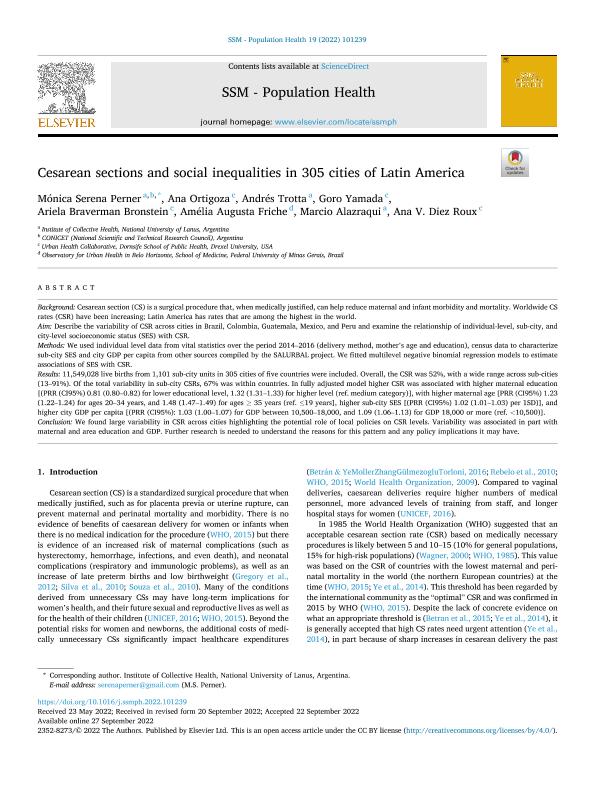Mostrar el registro sencillo del ítem
dc.contributor.author
Perner, Mónica Serena

dc.contributor.author
Ortigoza, Ana
dc.contributor.author
Trotta, Andrés

dc.contributor.author
Yamada, Goro
dc.contributor.author
Braverman Bronstein, Ariela
dc.contributor.author
Friche, Amélia Augusta
dc.contributor.author
Alazraqui, Marcio

dc.contributor.author
Diez Roux, Ana Victoria

dc.date.available
2023-12-27T14:20:39Z
dc.date.issued
2022-09
dc.identifier.citation
Perner, Mónica Serena; Ortigoza, Ana; Trotta, Andrés; Yamada, Goro; Braverman Bronstein, Ariela; et al.; Cesarean sections and social inequalities in 305 cities of Latin America; Elsevier; SSM - Population Health; 19; 9-2022; 1-8
dc.identifier.issn
2352-8273
dc.identifier.uri
http://hdl.handle.net/11336/221600
dc.description.abstract
Background: Cesarean section (CS) is a surgical procedure that, when medically justified, can help reduce maternal and infant morbidity and mortality. Worldwide CS rates (CSR) have been increasing; Latin America has rates that are among the highest in the world. Aim: Describe the variability of CSR across cities in Brazil, Colombia, Guatemala, Mexico, and Peru and examine the relationship of individual-level, sub-city, and city-level socioeconomic status (SES) with CSR. Methods: We used individual level data from vital statistics over the period 2014–2016 (delivery method, mother's age and education), census data to characterize sub-city SES and city GDP per capita from other sources compiled by the SALURBAL project. We fitted multilevel negative binomial regression models to estimate associations of SES with CSR. Results: 11,549,028 live births from 1,101 sub-city units in 305 cities of five countries were included. Overall, the CSR was 52%, with a wide range across sub-cities (13–91%). Of the total variability in sub-city CSRs, 67% was within countries. In fully adjusted model higher CSR was associated with higher maternal education [(PRR (CI95%) 0.81 (0.80–0.82) for lower educational level, 1.32 (1.31–1.33) for higher level (ref. medium category)], with higher maternal age [PRR (CI95%) 1.23 (1.22–1.24) for ages 20–34 years, and 1.48 (1.47–1.49) for ages ≥ 35 years (ref. ≤19 years], higher sub-city SES [(PRR (CI95%) 1.02 (1.01–1.03) per 1SD)], and higher city GDP per capita [(PRR (CI95%): 1.03 (1.00–1.07) for GDP between 10,500–18,000, and 1.09 (1.06–1.13) for GDP 18,000 or more (ref. <10,500)]. Conclusion: We found large variability in CSR across cities highlighting the potential role of local policies on CSR levels. Variability was associated in part with maternal and area education and GDP. Further research is needed to understand the reasons for this pattern and any policy implications it may have.
dc.format
application/pdf
dc.language.iso
eng
dc.publisher
Elsevier

dc.rights
info:eu-repo/semantics/openAccess
dc.rights.uri
https://creativecommons.org/licenses/by/2.5/ar/
dc.subject
CESAREAN SECTION
dc.subject
SOCIAL INEQUALITIES
dc.subject
MEDICALIZATION
dc.subject
MULTILEVEL ANALYSIS
dc.subject.classification
Epidemiología

dc.subject.classification
Ciencias de la Salud

dc.subject.classification
CIENCIAS MÉDICAS Y DE LA SALUD

dc.title
Cesarean sections and social inequalities in 305 cities of Latin America
dc.type
info:eu-repo/semantics/article
dc.type
info:ar-repo/semantics/artículo
dc.type
info:eu-repo/semantics/publishedVersion
dc.date.updated
2023-12-27T11:02:27Z
dc.journal.volume
19
dc.journal.pagination
1-8
dc.journal.pais
Países Bajos

dc.journal.ciudad
Amsterdam
dc.description.fil
Fil: Perner, Mónica Serena. Consejo Nacional de Investigaciones Científicas y Técnicas; Argentina. Universidad Nacional de Lanús; Argentina
dc.description.fil
Fil: Ortigoza, Ana. Drexel University; Estados Unidos
dc.description.fil
Fil: Trotta, Andrés. Universidad Nacional de Lanús; Argentina
dc.description.fil
Fil: Yamada, Goro. Drexel University; Estados Unidos
dc.description.fil
Fil: Braverman Bronstein, Ariela. Drexel University; Estados Unidos
dc.description.fil
Fil: Friche, Amélia Augusta. Universidade Federal de Minas Gerais; Brasil
dc.description.fil
Fil: Alazraqui, Marcio. Universidad Nacional de Lanús; Argentina
dc.description.fil
Fil: Diez Roux, Ana Victoria. Drexel University; Estados Unidos
dc.journal.title
SSM - Population Health
dc.relation.alternativeid
info:eu-repo/semantics/altIdentifier/url/https://linkinghub.elsevier.com/retrieve/pii/S235282732200218X
dc.relation.alternativeid
info:eu-repo/semantics/altIdentifier/doi/http://dx.doi.org/10.1016/j.ssmph.2022.101239
Archivos asociados
